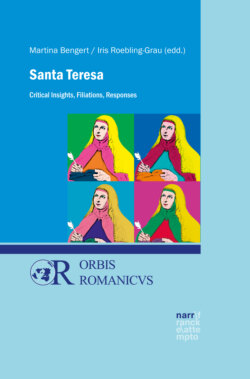Читать книгу Santa Teresa - Группа авторов - Страница 25
На сайте Литреса книга снята с продажи.
4. A Converso Perspective?
ОглавлениеConsidering Teresa’s words in her autobiography that she, “though not being a poet” (which is of course an understatement), “composed some deeply-felt verses well expressing her pain”1, the dark and tragic aspects in her poems cannot be ignored.2 She was acquainted with the problematic, often desperate situation of the conversos in Spain, not just due to her own family history. There is reason to assume that even some poems written for feasts, which do not show the meditative style of internalized prayer, can be read as mystical confessions owing to biblical inspiration, realizing the Christian faith as a divine interpretation of the Jewish tradition.
However, it would be wrong to conclude that an inner force to amalgamate different religious attitudes motivated her poetry. Rather, we find evidence for the unifying effect of mystical love by communal joy, the hidden messianic traditions of the conversos notwithstanding. In fact, this is evident from a note that prefaced the two villancicos on circumcision in the manuscript of Cuerva (dated 18th century):
Some more verses written by St. Teresa for the feast of circumcision for which she had a special devotion. One year, on the eve of that feast, while the nuns were at evening recreation, she came out of her cell almost beside herself with extraordinary fervor. Transported by her feelings, she danced and sang, and bade the community to join her, which they did with the greatest spiritual joy. Theirs was no set and ordinary kind of dance, nor was it accompanied by guitar, but the dancers beat time by clapping their hands, as David describes, Omnes gentes, plaudite manibus, as they moved to and fro with more spiritual harmony and grace than human art.3
The quotation of Psalm 47:2 is fitting in this context, for it opens the monastic morning prayer (Laudes). In addition, the biblical background provides hand clapping with an eschatological perspective. Jewish tradition also maintained this attitude, as can be learned from a medieval statement that Jewish rites intend clapping for both mourning and joy.4 Hence, the note in the Cuerva manuscript may indeed help gain insight into the historical context of Teresa’s poems and performance on the feast of circumcision. The question is not whether she kept up a clandestine Jewish identity (the answer is negative), but rather how she responded to those who did, or at least felt trapped between the hostile attitude of a Christian society on the one hand and the close relationship to their families on the other. The obvious hints to Davidic kingship and messianism in the context of Jesus’s circumcision contrast the past with the present: the incarnated Christ facing adversity and suffering pain versus contemporary threats – that is to say the Goliath of social injustice to the conversos. Consequently, Teresa’s poetry is emotionally charged to communicate redemption by a language of love and pain.
